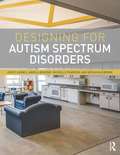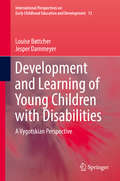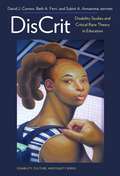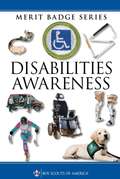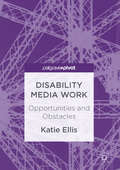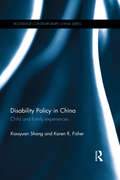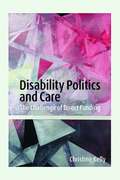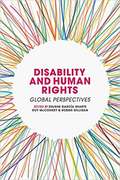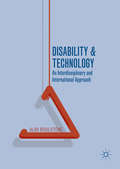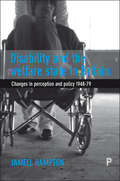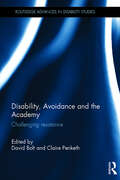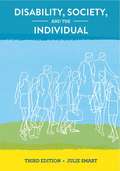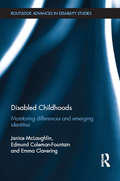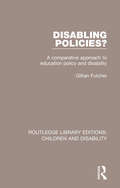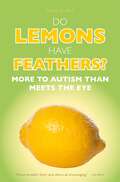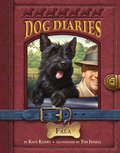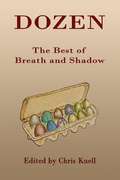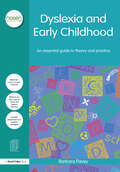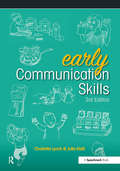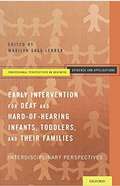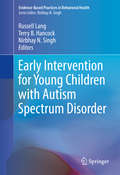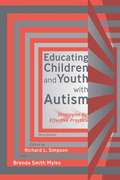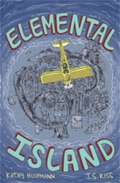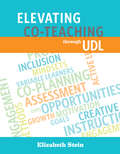- Table View
- List View
Designing for Autism Spectrum Disorders
by Angela Bourne Michelle Pearson Kristi Gaines Mesha KleibrinkWinner of the 2017 IDEC Book Award, 2017 EDRA Great Places Award (Book Category), 2017 American Society of Interior Designers Joel Polsky Prize and the 2016 International Interior Design Association TXOK Research Award Designing for Autism Spectrum Disorders explains the influence of the natural and man-made environment on individuals with autism spectrum disorders (ASD) and other forms of intellectual/developmental disabilities (IDD). Drawing on the latest research in the fields of environmental psychology and education, the authors show you how architecture and interior spaces can positively influence individuals with neurodiversities by modifying factors such as color, lighting, space organization, textures, acoustics, and ventilation. Now you can design homes, therapeutic environments, work environments, and outdoor spaces to encourage growth and learning for the projected 500,000 children with ASD (in the United States alone) who are expected to reach adulthood by 2024. Topics discussed include:-Environmental design theories-Symptoms of ASD-Sensory processing deficits -Design needs of individuals on the spectrum at all ages-Design methods and solutions for spaces, including residential, learning, work, and therapeutic environments encompassing a wide range of budgets-Designing for self-actualization, well-being, and a high quality of life for the duration of an individual's life-Avenues for healthy living and aging in place-Biophilic design-Environmental impact on well-being -Strategies to promote active living as an integral part of the welfare focus.
Development and Learning of Young Children with Disabilities
by Louise Boettcher Jesper DammeyerThis book introduces current theories and research on disability, and builds on the premise that disability has to be understood from the dialectical dynamics of biology, psychology, and culture over time. Based on the newest empirical research on children with disabilities, the book overcomes the limitations of the medical and social models of disability by arguing for a dialectical biopsychosocial model. The proposed model builds on Vygotsky's cultural-historical ideas of developmental incongruence, implying that the disability emerges from the misfit between individual abilities and the cultural-historical activity settings in which the child with impairments participates. The book is a theoretical contribution to an updated understanding of disability from a psychological and educational perspective. It focuses on the first years of the life of the child with impairment, and travels through infancy, toddler, preschool and early school age, to track the developmental trajectories of disability through the dialectical processes of cultural, social, individual, and biological processes. It discusses a number of themes that are relevant for the early development and support for children with various types and degrees of disability through the lens of Vygotsky's cultural-historical developmental theories. Some of the themes discussed are inclusion, mental health, communication, aids and family life.
DisCrit: Disability Studies and Critical Race Theory in Education
by David J. Connor Beth A. Ferri Subini A. AnnammaIn this groundbreaking volume, scholars examine the achievement/opportunity gaps from both historical and contemporary perspectives, as well as the overrepresentation of minority students in special education and the school-to-prison pipeline. Chapters also address school reform and the impact on students based on race, class, and dis/ability and the capacity of law and policy to include (and exclude).
Disabilities Awareness (Merit Badge Series)
by Boy Scouts of America StaffBoy Scouts of America Merit Badge Series: Disabilities Awareness.
Disability Media Work
by Katie EllisThis book interrogates trends in training and employment of people with disabilities in the media through an analysis of people with disabilities' self-representation in media employment. Improving disability representations in the media is vital to improving the social position of people with disability, and including people with lived experience of disability is integral to this process. While the media industry has changed significantly as a result of digital and participatory media, discriminatory attitudes around fear and pity continue to impact whether people with disability find work in the media. The book demonstrates no significant changes in attitudes towards employing disabled media workers since the 1990s when the last major research into this topic took place. By focusing on the employment of people with disability in media industries, Katie Ellis addresses a neglected area of media diversity, appealing to researchers in media and cultural studies as well as critical disability studies.
Disability Policy in China: Child and family experiences (Routledge Contemporary China Series)
by Xiaoyuan Shang Karen R. FisherWithout access to a public social welfare system in parts of China, some families face invidious decisions about the lives of their children with disabilities. In other places, children with disabilities can now expect to participate in their families and communities with the same aspirations as other children. Understanding how Chinese policy has changed in the places that have addressed these stark situations is vital for the rights of the children and their families who still struggle to find the support they need. This book examines family experiences of child disability policy in China, and is the first to compile research on this area. It applies a child disability rights framework in four domains – care and protection, economic security, development and participation – to investigate families’ experiences of the effectiveness of support to fulfil their children’s rights. Questioning how families experience the interrelationships between these rights, it also considers what the further implications of the policy are. It includes vivid case studies of families’ experiences, and combines these with national data to draw out the likely future policy directions to which the Chinese government has said it is committed. Bringing together a wealth of statistical and qualitative data on children with disabilities, this book will be of great interest to students and scholars of Chinese social welfare, social policy, society and children's studies, as well as policy-makers and NGOs alike.
Disability Politics and Care: The Challenge of Direct Funding
by Christine Kelly“We do not need care!” is a rallying cry for disability movements. It is informed by a recognition that a lack of choice over simple care decisions – like what to eat or what to wear – is a subtle yet pervasive form of violence endured by many disabled people. This book examines an independent living program to explore what happens when people with disabilities take control of their own care arrangements. The author documents responses by a wide range of stakeholders of this program and reflects on some of its broader social and political implications.
Disability and Human Rights: Global Perspectives
by Edurne García Iriarte Robbie Gilligan Roy McConkeyExperienced by more than one billion people worldwide, disability is increasingly recognised as a human rights issue internationally. Completely up to date, Disability and Human Rights draws on cutting edge international research and real life examples to explore the global dimension of disability and to critically review progress on the implementation of the United Nations Convention on the Rights of Persons with Disabilities. <P><P> This book provides readers with an in-depth exploration of disability across key areas of hu-man rights, including health, education, employment, accessibility and independent living. It demonstrates how these issues are integral to achieving full and equal participation of disa-bled people in human societies across the life cycle. The book analyses the impact of poverty, the importance of support and the relevance of culture and it maps out how to make disability rights a reality in the coming decades. <P><P> Chapters are enriched with a wide range of international case examples and questions for reflection to deepen readers' understanding of the material. Students and practitioners from a wide range of backgrounds, including disability studies, human rights, social work and social care will benefit from this much-needed new global perspective on disability.
Disability and Political Theory
by Nancy J. Hirschmann Barbara ArneilThough disability scholarship has been robust in history, philosophy, English, and sociology for decades, political theory and political science more generally have been slow to catch up. This groundbreaking volume presents the first full-length book on political theory approaches to disability issues. Barbara Arneil and Nancy J. Hirschmann bring together some of the leading scholars in political theory to provide a historical analysis of disability through the works of canonical figures, ranging from Hobbes and Locke to Kant, Rawls and Arendt, as well as an analysis of disability in contemporary political theory, examining key concepts, such as freedom, power and justice. Disability and Political Theory introduces a new disciplinary framework to disability studies, and provides a comprehensive introduction to a new topic of political theory.
Disability and Technology
by Alan RoulstoneThis book brings together formally disparate literatures and debates on disability and technology in a way that captures the complex interplay between the two. Drawing on disability studies, technology studies and clinical studies, the book argues that interdisciplinary insights together provide a more nuanced and less stylized picture of the benefits and barriers in disability and technology. Drawing on a breadth of empirical studies from across the globe, a picture emerges of the complex and multi-directional interplay of technology and disability. Technology is neither inherently enabling or disabling but fundamentally shaped by the social dynamics that shape their design, use and impact.
Disability and the Welfare State in Britain: Changes in Perception and Policy 1948–79
by Jameel HamptonCreated during and after the Second World War, the British Welfare State seemed to promise welfare for all, but, in its original form, excluded millions of disabled people. This book examines attempts in the subsequent three decades to reverse this exclusion. It is the first to contextualise disability historically in the welfare state and under each government of the period. It looks at how disability policy and perceptions were slow to change as a welfare issue, which is very timely in today’s climate of austerity. It also provides the first major analysis of the Disablement Income Group, one of the most powerful pressure groups in the period and the 1972 Thalidomide campaign and its effect on the Heath government. Given the recent emergence of the history of disability in Britain as a major area of research, the book will be ideal for academics, students and activists seeking a better understanding of the topic.
Disability, Avoidance and the Academy: Challenging Resistance (Routledge Advances in Disability Studies)
by David Bolt Claire PenkethDisability is a widespread phenomenon, indeed a potentially universal one as life expectancies rise. Within the academic world, it has relevance for all disciplines yet is often dismissed as a niche market or someone else’s domain. This collection explores how academic avoidance of disability studies and disability theory is indicative of social prejudice and highlights, conversely, how the academy can and does engage with disability studies. This innovative book brings together work in the humanities and the social sciences, and draws on the riches of cultural diversity to challenge institutional and disciplinary avoidance. Divided into three parts, the first looks at how educational institutions and systems implicitly uphold double standards, which can result in negative experiences for staff and students who are disabled. The second part explores how disability studies informs and improves a number of academic disciplines, from social work to performance arts. The final part shows how more diverse cultural engagement offers a way forward for the academy, demonstrating ways in which we can make more explicit the interdisciplinary significance of disability studies – and, by extension, disability theory, activism, experience, and culture. Disability, Avoidance and the Academy: Challenging Resistance will interest students and scholars of disability studies, education studies and cultural studies.
Disability, Society, and the Individual
by Julie SmartThis unique book provides a comprehensive examination of the disability experience. The content focuses on definitions of disability, societal response to people with disabilities, and the experience of disability from the perspectives of individuals with disability. It is organized around broad themes rather than disability categories. With an engaging writing style and extensive and completely updated references, Disability, Society, and the Individual-Third Edition prepares the reader to understand and be able to use complex, important, and new ideas surrounding disability -- its experience and social and cultural context. The text includes discussion questions, learning activities, suggested readings, and first-person accounts. PART I--Definitions of Disability PART II--Society and Disability PART III--The Individual and Disability
Disabled Childhoods: Monitoring Differences and Emerging Identities (Routledge Advances in Disability Studies)
by Edmund Coleman-Fountain Janice McLaughlin Emma ClaveringA crucial contemporary dynamic around children and young people in the Global North is the multiple ways that have emerged to monitor their development, behaviour and character. In particular disabled children or children with unusual developmental patterns can find themselves surrounded by multiple practices through which they are examined. This rich book draws on a wide range of qualitative research to look at how disabled children have been cared for, treated and categorised. Narrative and longitudinal interviews with children and their families, along with stories and images they have produced and notes from observations of different spaces in their lives – medical consultation rooms, cafes and leisure centres, homes, classrooms and playgrounds amongst others – all make a contribution. Bringing this wealth of empirical data together with conceptual ideas from disability studies, sociology of the body, childhood studies, symbolic interactionism and feminist critical theory, the authors explore the multiple ways in which monitoring occurs within childhood disability and its social effects. Their discussion includes examining the dynamics of differentiation via medicine, social interaction, and embodiment and the multiple actors – including children and young people themselves – involved. The book also investigates the practices that differentiate children into different categories and what this means for notions of normality, integration, belonging and citizenship. Scrutinising the multiple forms of monitoring around disabled children and the consequences they generate for how we think about childhood and what is ‘normal’, this volume sits at the intersection of disability studies and childhood studies.
Disabling Policies?: A Comparative Approach to Education Policy and Disability (Routledge Library Editions: Children and Disability #7)
by Gillian FulcherFirst published in 1989, this book is about integrating or mainstreaming policies, looking specifically at how to improve circumstances for schoolchildren with disabilities or handicaps, and their teachers. The author draws on her experiences, both within and outside the academic institution, to conceptualise and theorise policy, so as to place this policy in a political framework and locate it in a wider model of social life. This model is then used to disentangle the nature and effects of policy practices surrounding integration and mainstreaming, looking at practice in various parts of Europe, the US and Australia, at that time. Although written at the end of the 1980s, this book discusses topics that are still relevant today.
Do Lemons Have Feathers?: More to Autism than Meets the Eye
by David J. Burns Andrew Sercombe"Are you beginning to see past the disability and starting to appreciate the gift?" In this unashamedly honest book, David J. Burns draws on his own lived experience of Autism Spectrum Disorder (ASD) to provide guidance on how to take advantage of the supposed disadvantage. The book is filled with often hilarious anecdotes, spanning the confusion of his early diagnosis, to his marriage and life with his four children, as David proffers his advice on how to cope with everything from school work to flirting. Part memoir, part guide, and written with a refreshingly funny outlook, this book can be picked up and dipped into whether you're looking for encouragement, practical coping strategies, or a perspective of life as seen through the lens of ASD.
Dog Diaries #8: Fala
by Kate Klimo Tim JessellPresident Franklin Delano Roosevelt's Scottie dog Fala helps run a nation! As President Franklin Delano Roosevelt's nearly constant companion, Fala the Scottish terrier was in the unique position to witness the workings of the U.S. presidency. And now for the first time, the sassy Scottie shares his story with readers--from his idyllic puppyhood spent chasing squirrels through his adulthood spent chasing dignitaries around the world with FDR! This entertaining tail (that is, tale) gives middle-graders a dog's-eye view of the events leading up to the United States entering World War II, as well as a look at the private side of FDR's life in a wheelchair. Based on primary source material, with realistic black-and-white illustrations and an appendix including information about President Franklin Delano Roosevelt, World War II, Scottish terriers, and more, this is the kind of historical fiction that begs to be read by reluctant readers. It's a perfect choice for supporting Common Core State Standards.From the Trade Paperback edition.
Dozen: The Best of Breath and Shadow
by Chris KuellBreath and Shadow is a literary journal of disability culture, written and edited exclusively by people with disabilities. In this collection, editor Chris Kuell presents the best writing from the magazine's first 12 years. This collection of our best essays, poems, and short stories shines a light on the many gifts, ideas, and voices of writers who are disabled and removes many of the hurdles faced in mainstream publications. 100% of the proceeds from the sale of this anthology will go back into Breath and Shadow, allowing us to increase contributor payments and reach a wider and more diverse audience. To learn more, visit us at www. abilitymaine. org/breath
Dyslexia and Early Childhood: An essential guide to theory and practice (nasen spotlight)
by Barbara E. PaveyTaking a developmental approach, this accessible text addresses the ever increasing interest in identifying the characteristics of dyslexia in young children and reflects on the best way to reach and support these learners. Drawing upon current research, the author considers our current understanding of dyslexia and calls upon best practice to advise professionals, students and family members alike who seek to fulfil the potential of young children with, or showing the signs of, dyslexia. This book considers key topics explored in current best practice and dyslexia research, including: the importance of the role of speaking, hearing and understanding language dyslexia in relation to other languages and orthographies dyslexia and overlapping characteristics, particularly dyspraxia the role of play identifying and assessing dyslexia in the early years. Adopting a dyslexia-friendly position, Barbara Pavey acknowledges the ethics associated with a social model of disability, so that the focus is upon modifying teaching and learning, and respecting the views of children and parents throughout. This book includes assessment and practice strategies, good practice points, helpful ideas, first-hand narratives of dyslexia, pointers for further reading, resources and online tools, and will be of enormous practical use to anyone supporting a young child with potential or diagnosed dyslexia.
Early Communication Skills: 3rd edition (Early Skills)
by Charlotte Lynch Julia Kidd'Early Communication Skills' has been a popular and widely used publication since becoming available in 1991. Now in its third edition, the resource retains its original approach to communication, providing a source of fresh educational and therapeutic ideas for pre-school children. Special features: a question and answer section designed to answer all common concerns; exercise and worksheets; over 100 activities are provided, spanning all areas of communication from pre-verbal skills to early words. Charlotte Lynch, Paediatric Speech and Language Therapist. Julia Kidd, Paediatric Speech and Language Therapist.
Early Intervention For Deaf And Hard-of-hearing Infants, Toddlers, And Their Families: Interdisciplinary Perspectives
by Marilyn Sass-LehrerEarly Intervention for Deaf and Hard-of-Hearing Infants, Toddlers, and Their Families: Interdisciplinary Perspectives (Professional Perspectives On Deafness: Evidence and Applications) 1st Edition
Early Intervention for Young Children with Autism Spectrum Disorder
by Nirbhay N. Singh Russell Lang Terry B. HancockThis book examines early intensive behavioral intervention (EIBI) programs for young children with autism spectrum disorder (ASD). It analyzes current research on early intervention (EI) and explains the importance of accurate, timely detection of ASD in facilitating the use of EI. Chapters address five widely researched EIBI approaches: Discrete Trial Training, Pivotal Response Training, the Early Start Denver Model, Prelinguistic Milieu Teaching, and Enhanced Milieu Teaching. This in-depth study of current EIBI approaches offers a rigorous guide to earlier and more intensive interventions for children with ASD, leading to greater autonomy and improved later life outcomes for individuals. Featured topics include: Parent-implemented interventions and related issues. Evaluations of controversial interventions used with children with ASD. Factors contributing to rising ASD prevalence. Obstacles to obtaining accurate ASD diagnosis in young children. Early Intervention for Young Children with Autism Spectrum Disorder is an essential resource for researchers, clinicians, and graduate students in developmental, clinical child, and school psychology, behavioral therapy/rehabilitation, social work, public health, educational policy and politics, and related psychology and behavioral health fields.
Educating Children And Youth With Autism: Strategies For Effective Practice
by Brenda Smith Myles Richard L. SimpsonChildren and youth with autism spectrum disorders (ASD) have highly distinctive and idiosyncratic needs and characteristics. ASD is an especially challenging and perplexing disability. The need for knowledgeable and skilled educational professionals was the primary motivation for preparing this third edition of Educating Children and Youth With Autism: Strategies for Effective Practice. This edition includes chapters written by internationally recognized authorities on ASD.
Elemental Island
by Kathy Hoopmann J. S. Kiss*Silver medal winner in the 'Middle Grades Fiction' category of the Nautilus Book Awards 2015* Astie has always been different. Her 12th birthday is looming and she still has not decided on her thesis. All the Learners at the Hub picked theirs years ago. If it wasn't for her cousin, Jakob, life would be unbearable on Elemental Island. On the verge of being diagnosed with Social Syndrome, she stumbles upon Danny who has landed in a forbidden flight machine. To protect him, Astie persuades Jakob to tamper with the Overseer's memory. On the run from the Monitors together, Astie calls on her unique qualities to forge a friendship with the stranger and discover his reason for coming to the island. What she finds will shake the foundations of the place she calls home. Set on a secretive island utopia where science and logic rule, this intriguing novel explores and celebrates differences in people from an alternative perspective. It is engaging reading for children aged 8-13.
Elevating Co-Teaching through UDL
by Elizabeth SteinCo-teaching--the practice of having special education and regular education teachers work together in inclusive classrooms--is one way to ensure that all students have equal access to challenging academic content. But the practice is a challenging one, requiring thoughtful planning and execution by cooperative classroom professionals. Universal Design for Learning (UDL), a framework for designing inclusive learning environments, offers co-teachers structure and guidance in pursuing their goal to create successful learning environments for all students. In this book, veteran co-teacher and UDL expert Elizabeth Stein shows how to apply the UDL principles and guidelines to the practice of co-teaching. How does UDL inform the lesson-planning process? What does UDL look like in the classroom? What role does formative assessment play? How do you get buy-in for the UDL approach from administrators, parents, and students themselves? These and other questions are answered in this must-have book for anyone interested in co-teaching.
